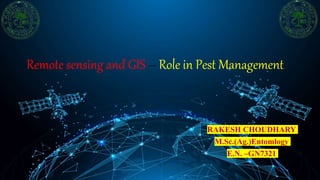
remote sensing and GIS -role in pest managment
- 1. Remote sensing and GIS – Role in Pest Management RAKESH CHOUDHARY M.Sc.(Ag.)Entomlogy E.N. –GN7321
- 2. Remote Sensing The art and science of obtaining information about an object, area or phenomenon through the analysis of data acquired by a device that is not in contact with the object under investigation. Remote sensing is a type of geospatial technology that samples emitted and reflected electromagnetic (EM) radiation from the Earth’s terrestrial, atmospheric, and aquatic ecosystems in order to detect and monitor the physical characteristics of an area without making physical contact.
- 3. Process of Remote Sensing
- 4. Remote sensing depends on measuring, recording, and processing the electromagnetic radiation reflected and emitted from the ground target. This method of data collection typically involves aircraft-based and satellite-based sensor technologies, which are classified as either passive sensors or active sensors The present review provides a perspective angle on the historical and cutting-edge strategies of remote sensing techniques and its applications, especially for insect pest and plant disease management. Remote sensing applications depend on the spectral behavior of living organisms.
- 5. Today, remote sensing is used as an effective tool for the detection, forecasting, and management of insect pests on different fruit orchards and crops. The main objectives of these applications were to collate data that help in decision-making for insect pest management and decreasing the environmental pollution of chemical pesticides. Furthermore, remote sensing using satellite information proved to be a promising tool in forecasting and monitoring the distribution of locust species. It has also been used to help farmers in the early detection of mite infestation in cotton fields using multi-spectral systems, which depend on color changes in canopy semblance over time. Remote sensing can provide fast and accurate forecasting of targeted insect pests and subsequently minimizing pest damage .
- 6. History of remote sensing October 4, 1957, the Soviet Union launched the earth's first artificial satellite, Sputnik. First meterology satellite was launched by US on 1st April ,1960 for weather forecast and it was named as earth resources Technology Satellite ( ERTS )- well suited for agriculture responses. These satellite are now referred to as LAND SAT. First remote sensing satellite in India was launched in 1988, named as IRS (Indian Remote Sensing ). Most recent – LAND SAT 9 launched on September 27, 2021.
- 7. Types of Remote Sensing Passive Active Passive Remote Sensing:- A system which measures energy that is naturally available. Example : Sun This can only take place during the time when the sun is illuminating the Earth. Active remote sensing It provide their own energy source of illumination. The server emits radiation which is directed towards the target to investigated. The radiation from that target is detected and measured by sensor.
- 8. Types of Remote Sensing platform Space-borne Air borne Ground based
- 9. Types of spectral scanner Multispectral Hyperspectral A scanning system used to collect data over a variety of different wavelength ranges is called a multispectral scanner (MSS). Hyperspectral remote sensing combines imaging and spectroscopy in a single system which often includes large data sets and require new processing methods.
- 10. Application of Remote sensing in Agriculture
- 11. Application of Remote sensing in Entomology Studies on incidence of insects. Studies on distribution of insects. Insect movements through radars. The observation of insect themselves by Photography and videography from aircraft and from the ground. The detection of the effects that insects produce (Symptoms). The monitoring of environmental factors likely to influence insect abundance, potential damage. The pest damage can be predicted with Spectral indices based on leaf pigments optical and video imaging in near infrared and microwave regions.
- 12. GIS ( Geographic Information System ) A GIS is a computer based system capable for capturing , storing, analysing and displaying geographically referenced information; that is data identified according to location.
- 13. Basic function of GIS Data acquisition and processing Database management and retrieval Spatial measurement and analysis Graphic output and visualization
- 14. Application of GIS in Agriculture
- 15. How GIS helps in IPM ? Scouting, Monitoring & Mapping Pest Populations Projecting pest outbreaks and movement Detecting and analyzing patterns of damage Precision application of control measures Reviewing the success of treatment strategies, and refining their use. It is major component of SSPM ( Site specific pest management )
- 16. What is Variable Rate Technology? VRT is based on variable rate application (VRA), which means applying materials in such a manner that the application rate is varied based on precise locations. VRA works by using either a map or a sensor-based system. The application follows a map, typically called a prescription map, based on GPS coordinates.
- 17. Disadvantage of Geo-spatial Technologies Expensive to build and operate. Data interpretation can be difficult. Need to understand theoretically how the instrument is making the measurements . Need to understand measurement uncertainties Need to have some knowledge of the phenomena you are sampling.
- 18. Remote sensing is a valuable tool for pest and disease detection and control in crops, as it can provide accurate, timely, and scalable information that can support pest management and crop protection By curate location information that aids pest management decisions GIS is also utilized to track monitoring measures such as spraying programs, trapping solutions, treatment ets. GIS can help forecast risk assessment models for pest control and management based on the data collected.
- 19. THANK YOU